Abstract
To combat climate change, the Chinese government has implemented a package of policies to support the development of the biogas power generation industry. However, the promotion of biogas power generation technology in China is relatively slow. Therefore, it is of practical significance to study the promotion of biogas power generation technology against the background of policy support. In order to study the effect of policy on the promotion of biogas power generation technology, a system dynamics model is constructed in this paper. The results show that under the feed-in tariff subsidy policy, biogas power generation technology can be well promoted because it has good economic and environmental effects. In addition, if the biogas power generation technology is considered to participate in carbon emission trading, the carbon price also has a positive impact on the promotion of biogas power generation technology because it increases the perceived economic value of biogas power generation projects. Finally, this study can also provide reference value for the promotion of biogas power generation technology in other areas.
1. Introduction
1.1. Background and Motivation
At present, China is in the critical phase of energy transformation; low-carbon energy transformation is the problem that needs to be solved now. The main energy consumption structure of coal has resulted in a large number of greenhouse gases, such as carbon dioxide emissions. In response to climate change, the Chinese government has duly set ambitious targets to achieve carbon peaking by 2030 and carbon neutrality by 2060 (“double carbon”) http://www.gov.cn/xinwen/2021-04/02/content_5597403.htm (accessed on 27 October 2022). Renewable energy generation has the characteristic of generating net zero carbon emissions. Increasing the proportion of renewable energy generation in the energy consumption structure will help mitigate greenhouse gas emissions. Biogas power generation is one of the biomass power generation technologies. Its advantages lie in the fact that, compared with other renewable energy power generation projects, biogas power generation projects have relatively less investment and simpler operation and maintenance in the later period. Therefore, it is suitable for promotion in areas rich in biogas resources.
Like other renewable energy generation technologies, cost and benefits are the most important factors restricting the promotion of biogas power generation technology. Therefore, the government has implemented relevant incentives to support the development of the biogas industry. The most important of these policies is the feed-in tariff, which is based on subsidies for electricity generated from renewable sources. Therefore, with the support of government policies, biogas power generation has achieved a certain scale of development. The adoption of biogas power generation technology refers to the process of biogas power generation projects being adopted by investors over time. According to public data, the installed capacity of biogas power generation will be 1,110,000 kW by 2021, https://www.sohu.com/a/600117257_120113054 (accessed on 27 October 2022). Alternatively, the raw materials of biogas power generation projects are all kinds of wastes containing organic matter, so the waste resources that can be used for biogas have great potential. In addition, China has rich biomass energy resources, so the biogas power generation project has the conditions for promotion.
In order to deal with environmental change, the Chinese government has continuously improved the top-level design of climate change work. For example, China has established a “1 + N” policy system for carbon peaking and carbon neutrality to control greenhouse gas emissions in the medium to long term, http://www.gov.cn/xinwen/2021-07/14/content_5624831.htm (accessed on 2 November 2021). Biogas is an efficient, safe, and environmentally friendly clean fuel. Biogas power generation helps reduce carbon emissions and improve environmental performance. In the context of carbon peaking and carbon neutrality, the development of biogas power generation technology is helpful to reduce carbon dioxide emissions. In the process of realizing the goal of double carbon, biogas power generation will be more widely used. Utilization of biogas resources can replace fossil fuel power generation to a certain extent. Alternatively, it can reduce the emission of harmful gases and realize the reuse of waste resources. With the progress of biogas production [1,2], this makes the biogas power generation industry promising.
China’s biogas power generation has a broad development prospect due to the abundant biomass resources [3]. However, the development of the biogas power generation industry is not fast due to the cost and the need to improve industrialization. Although a biogas power generation project has certain economic benefits and investment feasibility, in the promotion process of a biogas power generation project, investors’ investment intentions are not high; therefore, there is a problem, namely, how to promote a biogas power generation project to achieve biogas resource utilization. This is a problem worth studying. Therefore, the research questions are: how can we encourage investors to invest in biogas power generation projects? What is the effect of government policies on the promotion of biogas power generation projects? This is the question that needs to be solved in this paper. To solve these questions, this paper utilized a system dynamics model to study the diffusion of biogas power generation projects under the subsidy policy.
1.2. Literature Review
At present, there are a lot of research results on biogas power generation. First of all, from the perspective of influencing factors for the promotion of biogas power generation technology, the factors affecting biogas power generation projects mainly include: policy factors, financial support, environmental awareness, as well as social acceptance [3,4]. For example, Mukeshimana et al. [5] analyzed the constraints on the adoption of biogas technology, and the research results indicate that finance, technology, society, policies, and institutions are the main factors affecting the adoption of biogas in developing countries. Tigabu et al. [6] analyzed the biogas technology in Rwanda based on the technology innovation system, and the research showed that the technology innovation capability was the main reason restricting the low adoption rate of biogas technology in Rwanda. In order to study the dynamic factors and hindrance factors of biogas technology popularization, Ahmed et al. [7] conducted research on the diffusion of biogas technology in Pakistan. The research shows that grid accessibility, social acceptance, and energy security are the driving forces behind the diffusion of biogas technology, while biogas equipment maintenance and a long payback period are barriers to its adoption. Alternatively, the insufficient supply of biogas resources, high installation costs, and lack of technical information are also the main factors affecting the adoption of biogas.
In terms of cost and benefits, investment costs are an important factor hindering the popularization of environmentally friendly technologies [8,9]. The biogas power generation project is analyzed in terms of a cost-benefit analysis to determine its technical feasibility. It is mainly determined by economic benefits, payback period, and return on investment. For example, Budzianowski [10] analyzed the development prospects and challenges of biogas technology and showed that the key factors affecting biogas investment were economic measures, the availability of raw materials, and the reliability of biogas technology. According to Bakhtiar [11], investment, technology, and infrastructure are the main influencing factors for the commercial diffusion of biomass energy. Zhang and Xu [12] analyzed the economic and environmental benefits of biogas power generation projects based on life cycle analysis, and the results showed that large-scale biogas power generation projects had good economic and environmental benefits. However, despite the economic and environmental benefits of biogas technology, the adoption rate is not high in developing countries. Bekchanov [13] believed that biogas power generation technology was adopted with the support of government policies, and the lack of economic incentives and environmental awareness were the factors that led to the reluctance to adopt. Therefore, biogas power projects depend on policy incentives.
As for policy tools, Venus [14] believed that the feed-in tariff policy played an important role in the promotion of biogas power generation technology in Germany, while the gradual cancellation of the subsidy policy would bring challenges to the biogas power generation industry. Wang et al. [15] studied the deployment of waste power generation under the feed-in tariff subsidy policy, and the research results showed that the feed-in tariff subsidy policy had a positive impact on the installed capacity of waste power generation. Secondly, improving the technological progress level of the waste power generation industry could reduce the investment costs for investors. Xin-gang et al. [16] constructed a system dynamics model to study the impact of feed-in tariff subsidy policy and a renewable energy quota system on the waste power generation industry, and the results show that market-based tools are sustainable in the long run. Subsidy policy plays an important guiding role for biogas power generation technology [17]. Kozłowski et al. [18] think that if there is no subsidy, biogas power generation projects are not profitable. According to [19], the promotion of biogas power generation technology needs the support of a package of government policy tools, including feed-in tariffs, quotas, bidding, etc. Therefore, the biogas power generation market in Germany is more mature. Biogas power generation technology can solve people’s increasing energy needs; alternatively, it can also deal with the accumulation of waste. Therefore, Borges et al. [20] evaluated the potential of biogas in Brazil. The study showed that the lack of policies to incentivize production and R&D purposes is the reason for the slow growth of biogas power generation technology, while at the same time creating challenges for adopters to overcome the initial investment costs. Lauven et al. [21] believed that in the absence of incentives, biogas plants would be uncompetitive in the market.
Last, there are also studies from the perspectives of information and social acceptance [4]. Zepter et al. [22] believe that biogas power generation can play an important role in the green energy transition because of its huge power generation potential. This leads to stress in the distribution system as renewable energy generation is added to the grid. The integrity of distribution network facilities will also have an impact, hence the need to strengthen the construction of grid infrastructure. In addition, potential investors will also obtain relevant information from investors, so information factors will also have an impact on the decision-making behavior of potential adopters. Rahman et al. [23] studied biogas application through a questionnaire survey, and the research showed that the availability of funds plays a key role in promoting the adoption of biogas technology. In addition, the spread of biogas technology can alleviate the impact of poverty because of its environmental effects. From the perspective of public acceptance, the higher the level of technical knowledge of biogas production, the higher the level of public acceptance of biogas technology [24]. In terms of research methods, this paper reviews relevant literature and summarizes it, as shown in Table 1.

Table 1.
The relevant literature can be summarized as follows.
1.3. Contributions and Innovations
- (1)
- Compared with previous research, the research themes of existing research mainly focus on the identification and cost-benefit analysis of the promotion factors of biogas power generation projects, but there are few studies on the diffusion of biogas power generation projects. Therefore, this paper studies the promotion of biogas power generation projects from the perspective of policy effects. This can provide relevant decision support for biogas power generation project investors and related policymakers.
- (2)
- In terms of research methods, existing research generally identifies the influencing factors of biogas power generation technology through a questionnaire survey. However, the promotion of biogas technology is a dynamic process, and the traditional quantitative methods cannot reflect this dynamic process. In view of this, this paper uses the system dynamics model to study the promotion process of biogas power generation technology under the policy effect.
2. Materials and Methods
Biogas as a resource has huge potential in China. Reasonable utilization of biogas resources can alleviate greenhouse gas emissions; the electricity generated by biogas power generation can avoid the carbon emissions generated by other fossil fuel power generation (such as coal), thus achieving the effect of carbon reduction. Alternatively, the acquisition of biogas raw materials by biogas power generation manufacturers can bring economic benefits to areas rich in biogas resources. Therefore, it is of practical significance to study the diffusion of biogas power generation technology against the background of double carbon.
In the research of renewable energy technology diffusion, a system dynamics model is often used to study the influence of various factors on the installed capacity of renewable energy. Its advantage is that the system dynamics model can study the interaction between various factors. Therefore, the system dynamics model is used to study the diffusion of biogas power generation technology.
Based on this, the main purpose of this paper is to investigate the effects of policy on the diffusion of biogas plants. The whole causal loop is shown in Figure 1.
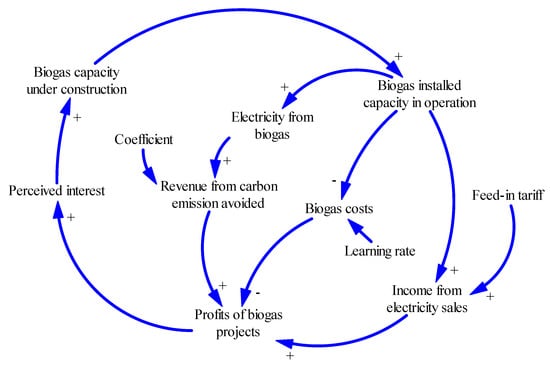
Figure 1.
The diffusion of biogas projects.
Model Construction
As for the revenue from biogas projects, profit maximization is the criterion influencing the adoption of biogas technology. Therefore, maximizing economic benefits is the main motivation for technology adoption. Biogas can generate electricity and feed it into the grid, where it can be sold for a financial return. As an efficient, safe, and environmentally friendly clean fuel, biogas resource utilization can reduce carbon emissions. The existing studies often consider the carbon emission reduction income when considering the economic value of renewable energy projects [3,27]. Therefore, the income composition of the biogas power generation project includes power generation income and environmental benefits [3], so the formula can be expressed as:
where denotes income from sales of biogas power generation, denotes biogas generation, is feed-in tariff. Biogas power generation is a form of biomass energy generation that also enjoys the government’s online preferential policies. According to our government’s support for the biogas power generation industry, its on-grid electricity price is 0.75 CNY. denotes revenue from reduced carbon emissions and is the carbon price.
As for the cost of biogas, a learning curve is a tendency for the unit cost of a technology to decline as experience in manufacturing it is gained [28]. In renewable energy research, the learning curve is often used to measure the impact of technological advances on investment costs. Considering the impact of technological progress on the investment cost, and due to the availability of data, this paper measures the dynamic impact of technological progress on the technology cost of biogas power generation based on the single factor learning curve.
where is the equipment cost of biogas power, is raw material cost of biogas, denotes operation and maintenance cost of biogas, is other costs of biogas. According to [28], the learning index of the single factor model is 0–24%, and the average value is 11%. Borges et al. [20] set this value at 10% when studying the learning index of biogas power generation technology. From this, we can calculate the value of the investment cost of a biogas power generation project as it changes over time.
The abbreviations of this paper are shown in Table 2.

Table 2.
The abbreviation of this paper.
3. Results and Discussion
3.1. Results
To investigate the different policies on the deployment of biogas, this study chose the FIT and carbon price. The starting point of simulation time is 2015, and 2020–2025 is prediction time.
- (1)
- The effects of different FITs on biogas power generation projects
As we can see from Figure 2 and Figure 3, as the intensity of the feed-in tariff increases, the installed capacity of biogas in operation also increases. Meanwhile, attracted by the subsidy policy, the profits available to investors also increased correspondingly. It can be seen that the feed-in tariff subsidy policy is highly attractive to biogas project investors. It is designed to subsidize the power generated from biogas technology, so the more biogas generation, the greater the expected profit, which increases the enthusiasm of biogas power generation investors and reduces the investment risk.
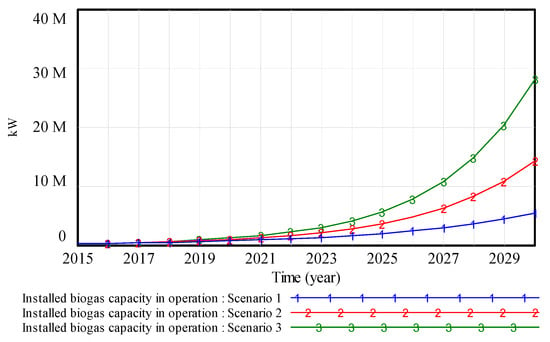
Figure 2.
The installed biogas capacity in operation.
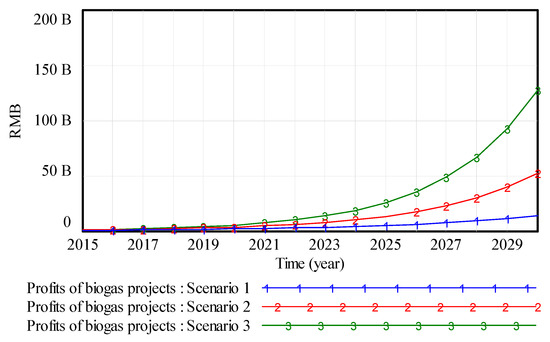
Figure 3.
The profits of biogas projects 1 (USD = 6.7722 CNY).
- (2)
- Influence of carbon pricing on biogas power generation projects
The simulation results are shown in Figure 4 and Figure 5 and Figure 6. The level of carbon pricing also has an impact on investors in biogas power generation projects. The higher the carbon price, the higher the carbon emission reduction income investors can get from investing in biogas power generation projects. At this time, the investor can not only obtain the income from the sale of biogas power generation in the investment project; investors can also get the corresponding carbon emission reduction income from the carbon trading market. Therefore, as the income of biogas power generation projects increases, investors’ willingness to invest will also increase.
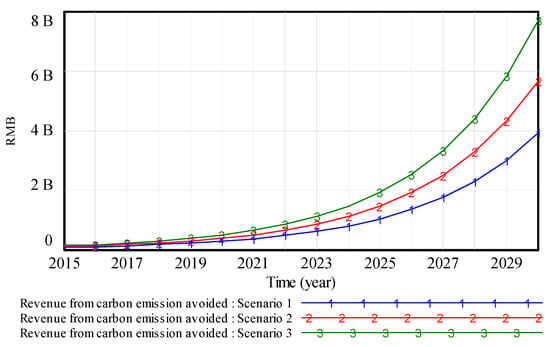
Figure 4.
The revenue from avoided carbon emissions.
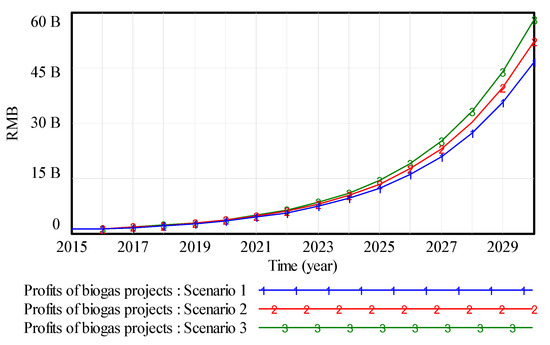
Figure 5.
The profits of biogas projects.
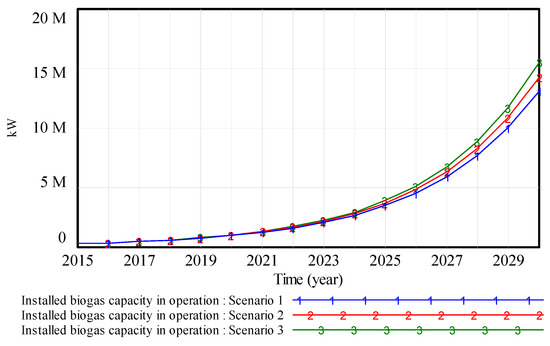
Figure 6.
The biogas installed capacity in operation.
3.2. Discussion
Existing studies believe that government subsidy policies are crucial to the development of the biomass power generation industry, especially biogas power generation technology. This is because government subsidy policies can increase investors’ profit expectations and reduce investment uncertainty and risks. Zhang et al. [3] studied the investment decision-making of biomass power generation technology from the perspective of real options. The research shows that government subsidies can attract investors to invest in biomass power generation projects, and the price level of carbon emissions also affects the investment projects’ economic value. Guo et al. [29] believe that biomass power generation projects have the potential to reduce carbon emissions, and the carbon trading market can help improve the profitability of biomass power generation projects. Thapa et al. [30] believe that the environmental income generated by biogas power generation can increase investors’ willingness to invest in biogas power generation technology, thus realizing the adoption of biogas power generation technology. Chung et al. [17] believed that policies can promote biogas development, but different types of policy tools have different emphases, so it is necessary to use policy tools in a coordinated manner. Xue et al. [31] make a comparative analysis of the development situation of biogas in China and Europe, and the research shows that in order to promote the development of the biogas industry, it is necessary to adhere to the market drive. As can be seen from the above research, policy plays an important role in the development of the biogas industry. The reason for the slow spread of biogas power generation technology is the cost of investment, and the perceived return on investment is the most important factor to attract adopters. This is consistent with our findings. In the future, the development of the biogas power generation industry will scale up with the support of the government. Investors need to pay attention to the technical progress level of the biogas power generation industry and reduce costs through continuous technological improvement.
4. Conclusions and Outlook
The Chinese government is actively responding to the impact of climate change, such as by optimizing the energy mix and increasing the proportion of renewable energy generation in the energy consumption mix. In order to reduce greenhouse gas emissions, our government has put forward a carbon peak and carbon neutral program. As a sustainable biomass resource, biogas power generation technology has the characteristics of being clean and low-carbon. Therefore, the development of biogas power generation technology is conducive to the realization of energy savings and emission reduction goals. In order to support the development of the biogas power generation industry, the government has also implemented a package of policies and measures to support its development. However, the development of biogas power generation technology in China is relatively slow. Therefore, it is of practical significance to study the promotion of biogas power generation technology under the policy incentive. Based on this, this paper utilizes a system dynamics model to study the promotion of biogas power generation technology under the policy incentive. The results show that the economic benefit of biogas power generation projects is an important factor affecting the promotion of biogas power generation technology. When the intensity of policy subsidies is higher, the benefit that investors in biogas power generation projects can obtain is higher, and investors are more willing to invest in this power generation technology. In addition, the results also show that when biogas power generation technology can participate in the carbon trading market in the future, the carbon price will have a positive impact on the promotion of biogas power generation technology. Based on the above research results, this paper puts forward the following policy recommendations:
First of all, biogas power generation technology requires a relatively large amount of initial investment, so its promotion needs to rely on the support of government policies. Therefore, the price subsidy policy for biogas power generation projects can mobilize the enthusiasm of investors to invest in biogas power generation projects and promote the rapid development of the biogas power generation industry. However, there is also a problem: the cost of government subsidies increases; alternatively, with the technological progress of the biogas power generation industry, the investment cost of a biogas power generation project will show a downward trend over time. Therefore, the price subsidy policy should be adjusted timely, and the reasonable formulation of the feed-in price subsidy policy can promote the development of the industry.
Secondly, the government should improve relevant policies and lead the biogas power generation industry by strengthening guidance so as to create a good environment for the biogas power generation industry. By giving play to the market mechanism, actively guide all kinds of capital to invest in biogas power generation projects so as to form industrialization and development and constantly improve economic and environmental benefits. Moreover, the industry standard for biogas power generation should be improved to create conditions for its commercial development and utilization. Finally, in terms of financing channels, the financial sector can provide financing models with multiple channels to provide investors with corresponding loans, thus increasing the attraction of investors’ investments. In terms of publicity and popularization, it is necessary to increase technical publicity, such as through the establishment of demonstration and application pilots and the publicity of the economic and technological advantages of biogas power generation, so as to promote public familiarity and acceptance.
Lastly, the limitation of this paper is that it only considers the impact of feed-in tariff subsidies and carbon pricing on biogas power generation. In addition, in the future, if the availability of data is satisfied, other methods can be combined to further analyze the sustainable development of the biogas power generation industry. Alternatively, the characteristics of the adopters, such as knowledge, information access, economic affordability, and risk preference, determine the heterogeneity of the adopters, which will lead to different decision-making behaviors. As a bottom-up model, the multi-agent model can better represent the change in decision-making behavior and psychological characteristics of the adopters at the micro level. In the diffusion process, the decision-making behavior of adopters is the basis of investment in biogas power generation projects. Future research can use the multi-agent model to depict this diffusion process.
Author Contributions
W.W.: Conceptualization, Methodology, Software, Formal analysis, Writing—Original Draft, Visualization, Resources, Data Curation; Z.X.-g.: Validation, Investigation, Funding acquisition, Supervision, Project administration; H.S.: Formal analysis, Writing—Original Draft, Visualization; L.W.: Formal analysis, Writing—Original Draft. All authors have read and agreed to the published version of the manuscript.
Funding
This paper is supported by the Beijing Municipal Social Science Foundation (No. 16JDYJB031), the Fundamental Research Funds for the Central Universities (No. 2020YJ008) and the Fundamental Research Funds for the Central Universities (No. 2018ZD14).
Institutional Review Board Statement
Not applicable.
Informed Consent Statement
Not applicable.
Data Availability Statement
Not applicable.
Acknowledgments
We would like to express our sincere thanks to the editor for his time and effort in processing the manuscript. We would also like to thank the anonymous reviewers for their valuable comments.
Conflicts of Interest
The authors declare no conflict of interest.
References
- Tabatabaei, M.; Aghbashlo, M.; Valijanian, E.; Panahi, H.K.S.; Nizami, A.-S.; Ghanavati, H.; Sulaiman, A.; Mirmohamadsadeghi, S.; Karimi, K. A comprehensive review on recent biological innovations to improve biogas production, part 1: Upstream strategies. Renew. Energy 2020, 146, 1204–1220. [Google Scholar] [CrossRef]
- Tabatabaei, M.; Aghbashlo, M.; Valijanian, E.; Panahi, H.K.S.; Nizami, A.-S.; Ghanavati, H.; Sulaiman, A.; Mirmohamadsadeghi, S.; Karimi, K. A comprehensive review on recent biological innovations to improve biogas production, part 2: Mainstream and downstream strategies. Renew. Energy 2020, 146, 1392–1407. [Google Scholar] [CrossRef]
- Zhang, M.; Zhou, D.; Ding, H.; Jin, J. Biomass power generation investment in China: A real options evaluation. Sustainability 2016, 8, 563. [Google Scholar] [CrossRef]
- He, P.; Lovo, S.; Veronesi, M. Social networks and renewable energy technology adoption: Empirical evidence from biogas adoption in China. Energy Econ. 2022, 106, 105789. [Google Scholar] [CrossRef]
- Mukeshimana, M.C.; Zhao, Z.Y.; Ahmad, M.; Irfan, M. Analysis on barriers to biogas dissemination in Rwanda: AHP approach. Renew. Energy 2021, 163, 1127–1137. [Google Scholar] [CrossRef]
- Tigabu, A.D.; Berkhout, F.; van Beukering, P. Technology innovation systems and technology diffusion: Adoption of bio-digestion in an emerging innovation system in Rwanda. Technol. Forecast. Soc. Chang. 2015, 90, 318–330. [Google Scholar] [CrossRef]
- Ahmed, N.; Qamar, S.; Jabeen, G.; Yan, Q.; Ahmad, M. Systematic analysis of factors affecting biogas technology acceptance: Insights from the diffusion of innovation. Sustain. Energy Technol. Assess. 2022, 52, 102122. [Google Scholar] [CrossRef]
- Kabera, T.; Nishimwe, H.; Imanantirenganya, I.; Mbonyi, M.K. Impact and effectiveness of Rwanda’s National Domestic Biogas programme. Int. J. Environ. Stud. 2016, 73, 402–421. [Google Scholar] [CrossRef]
- Joshi, J.; Wang, J. Manure management coupled with bioenergy production: An environmental and economic assessment of large dairies in New Mexico. Energy Econ. 2018, 74, 197–207. [Google Scholar] [CrossRef]
- Budzianowski, W.M. Sustainable biogas energy in Poland: Prospects and challenges. Renew. Sustain. Energy Rev. 2012, 16, 342–349. [Google Scholar] [CrossRef]
- Bakhtiar, A.; Aslani, A.; Hosseini, S.M. Challenges of diffusion and commercialization of bioenergy in developing countries. Renew. Energy 2020, 145, 1780–1798. [Google Scholar] [CrossRef]
- Zhang, C.; Xu, Y. Economic analysis of large-scale farm biogas power generation system considering environmental benefits based on LCA: A case study in China. J. Clean. Prod. 2020, 258, 120985. [Google Scholar] [CrossRef]
- Bekchanov, M.; Mondal, A.H.; de Alwis, A.; Mirzabaev, A. Why adoption is slow despite promising potential of biogas technology for improving energy security and mitigating climate change in Sri Lanka? Renew. Sustain. Energy Rev. 2019, 105, 378–390. [Google Scholar] [CrossRef]
- Venus, T.E.; Strauss, F.; Venus, T.J.; Sauer, J. Understanding stakeholder preferences for future biogas development in Germany. Land Use Policy 2021, 109, 105704. [Google Scholar] [CrossRef]
- Wei, W.; Xin-Gang, Z.; Jieying, W. Can support policies promote the innovative diffusion of waste-to-energy technology? Environ. Sci. Pollut. Res. 2022, 29, 55580–55595. [Google Scholar] [CrossRef]
- Xin-Gang, Z.; Yu-Zhuo, Z.; Ling-Zhi, R.; Yi, Z.; Zhi-Gong, W. The policy effects of feed-in tariff and renewable portfolio standard: A case study of China’s waste incineration power industry. Waste Manag. 2017, 68, 711–723. [Google Scholar] [CrossRef]
- Chung, C.C.; Liu, L.; Zhang, Y.; Wang, Y.; Wei, Z. Evolution of biogas policies in China (2001–2019): Dynamics of policy instruments towards energy transitions. J. Clean. Prod. 2022, 379, 134642. [Google Scholar] [CrossRef]
- Kozłowski, K.; Pietrzykowski, M.; Czekała, W.; Dach, J.; Kowalczyk-Juśko, A.; Jóźwiakowski, K.; Brzoski, M. Energetic and economic analysis of biogas plant with using the dairy industry waste. Energy 2019, 183, 1023–1031. [Google Scholar] [CrossRef]
- Banja, M.; Jégard, M.; Motola, V.; Sikkema, R. Support for biogas in the EU electricity sector–A comparative analysis. Biomass Bioenergy 2019, 128, 105313. [Google Scholar] [CrossRef]
- Borges, C.P.; Sobczak, J.C.; Silberg, T.R.; Uriona-Maldonado, M.; Vaz, C.R. A systems modeling approach to estimate biogas potential from biomass sources in Brazil. Renew. Sustain. Energy Rev. 2021, 138, 110518. [Google Scholar] [CrossRef]
- Lauven, L.P.; Geldermann, J.; Desideri, U. Estimating the revenue potential of flexible biogas plants in the power sector. Energy Policy 2019, 128, 402–410. [Google Scholar] [CrossRef]
- Zepter, J.M.; Engelhardt, J.; Gabderakhmanova, T.; Marinelli, M. Empirical validation of a biogas plant simulation model and analysis of biogas upgrading potentials. Energies 2021, 14, 2424. [Google Scholar] [CrossRef]
- Rahman, M.S.; Majumder, M.K.; Sujan, M.H.K. Adoption determinants of biogas and its impact on poverty in Bangladesh. Energy Rep. 2021, 7, 5026–5033. [Google Scholar] [CrossRef]
- Mazzanti, M.; Modica, M.; Rampa, A. The biogas dilemma: An analysis on the social approval of large new plants. Waste Manag. 2021, 133, 10–18. [Google Scholar] [CrossRef]
- Sarker, S.A.; Wang, S.; Adnan, K.M.; Sattar, M.N. Economic feasibility and determinants of biogas technology adoption: Evidence from Bangladesh. Renew. Sustain. Energy Rev. 2020, 123, 109766. [Google Scholar] [CrossRef]
- Ahmad, M.; Khan, I.; Khan, M.Q.S.; Jabeen, G.; Jabeen, H.S.; Işık, C. Households’ perception-based factors influencing biogas adoption: Innovation diffusion framework. Energy 2023, 263, 126155. [Google Scholar] [CrossRef]
- Wang, X.; Cai, Y.; Dai, C. Evaluating China’s biomass power production investment based on a policy benefit real options model. Energy 2014, 73, 751–761. [Google Scholar] [CrossRef]
- Rubin, E.S.; Azevedo IM, L.; Jaramillo, P.; Yeh, S. A review of learning rates for electricity supply technologies. Energy Policy 2015, 86, 198–218. [Google Scholar] [CrossRef]
- Guo, H.; Cui, J.; Li, J. Biomass power generation in China: Status, policies and recommendations. Energy Rep. 2022, 8, 687–696. [Google Scholar] [CrossRef]
- Thapa, S.; Morrison, M.; Parton, K.A. Willingness to pay for domestic biogas plants and distributing carbon revenues to influence their purchase: A case study in Nepal. Energy Policy 2021, 158, 112521. [Google Scholar] [CrossRef]
- Xue, S.; Song, J.; Wang, X.; Shang, Z.; Sheng, C.; Li, C.; Zhu, Y.; Liu, J. A systematic comparison of biogas development and related policies between China and Europe and corresponding insights. Renew. Sustain. Energy Rev. 2020, 117, 109474. [Google Scholar] [CrossRef]
Disclaimer/Publisher’s Note: The statements, opinions and data contained in all publications are solely those of the individual author(s) and contributor(s) and not of MDPI and/or the editor(s). MDPI and/or the editor(s) disclaim responsibility for any injury to people or property resulting from any ideas, methods, instructions or products referred to in the content. |
© 2023 by the authors. Licensee MDPI, Basel, Switzerland. This article is an open access article distributed under the terms and conditions of the Creative Commons Attribution (CC BY) license (https://creativecommons.org/licenses/by/4.0/).